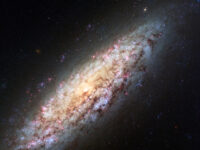Lightning is not uncommon, nor is it particularly subtle. In fact, with approximately 9 million strikes per day, it is one of the loudest, brightest, and most common natural phenomena known to the terrestrial sciences.
Most people know lightning as loud arcs of light that sometimes occur during severe storms. Indeed, this is the most common form. However, much stranger electrical phenomena, from floating balls of light to glowing pieces of plane fuselages have also been described.
That being said, with references dating back to antiquity and academic consideration beginning as far back as Benjamin Franklin’s first foray into electrostatics in 1746, lightning should be understood quite well — if meteorology were ever that simple.
The classic arc-shaped lightning strike is the most thoroughly documented type of lightning. Nevertheless, its formation is still debated in academia, with its underlying mechanism being unknown and rather contested, though most every model begins with triboelectricity.
The triboelectric effect, better known as static electricity, is the observation that rubbing certain materials together produces an electrostatic charge like wool socks on carpet. Triboelectricity has been observed for millennia, with the Ancient Greeks writing of rubbing animal fur and amber together to produce sparks, from which we derive the term “electricity,” from the Greek ἤλεκτρον (ḗlektron), meaning “amber.”
It is thought that strong updrafts in thunderclouds are able to lift small ice crystals high into the atmosphere, rubbing past falling masses of soft hail called graupel, producing triboelectricity. These ice crystals carry positive charge upward, concentrating at the top of the cloud, with the opposite occurring for negative charge at the bottom of the cloud.
While this explanation for the accumulation of charge is generally accepted (except for the number of regions of charge created, which is a much more complex problem), the problem of how and why these pockets spontaneously and violently discharge is heavily debated.
Whether the charges produced are strong enough to break through the air, or whether the lightning needs a catalyst to form is debated. What that catalyst may be, whether more ice crystals or cosmic rays, is also uncertain. What little is certain, is that lightning occurs and that it involves electrostatic discharge of some variety; all else is of continuing research and debate.
“What little is certain, is that lightning occurs and that it involves electrostatic discharge of some variety; all else is of continuing research and debate.”
Two lesser-known and more elusive forms of lightning are Saint Elmo’s fire and ball lightning. Both phenomena are extremely rare and very different from traditional arc lightning, sighted most often (but, strangely, not exclusively) during thunderstorms.
The former, named Saint Elmo’s fire after the patron saint of sailors in Christianity, is a phenomenon by which high-altitude high-conductivity structures may begin to glow and emit sparks, similarly to a Tesla coil. The event was most commonly reported by sailors at sea during storms, who would report seeing the metal tip of their ship’s masts glowing ethereally.
The leading theory for Saint Elmo’s fire is quite similar to that for traditional lightning, with the same ice-graupel polarization process accounting for the required charge difference for ionization of the air surrounding the conductor. The main difference, aside from the incredible rarity of the event, is that the metal conductor much more easily handles the resulting discharge, leading not to a quick, severe clap of thunder, but a slow burning of fire abreast the conductor.
The last major lighting-adjacent phenomenon is ball lightning, perhaps the most mysterious event in all of meteorology. Very few have seen ball lightning, so few that its existence was questioned even up until the advent of photography.
In general, ball lightning is described as an ethereal ball of light suddenly appearing in the open, whether in a storm or in the clear evening air, usually disappearing within seconds. However, reports of shape, size, color, duration, altitude, and intensity all differ wildly.
Unlike classical lightning and Saint Elmo’s fire, there is no clear explanation for the phenomenon, nor is there even a consensus. In a review of the current scientific literature, researchers Mikhail Shmatov and Karl Stephan describe there being “dozens” of competing ball lightning models, none of which account for even a majority of the eight criteria most often associated with the event.
“This is all to say that lighting, while a quotidian phenomenon in many parts of the world, is anything but straightforward. “
This is all to say that lighting, while a quotidian phenomenon in many parts of the world, is anything but straightforward. From arcs, to balls, to glowing halos, it takes on many different forms and functions. With millennia of research yet to reach a consensus, it shows us that science has yet more to learn about even the most conspicuous of phenomena.






